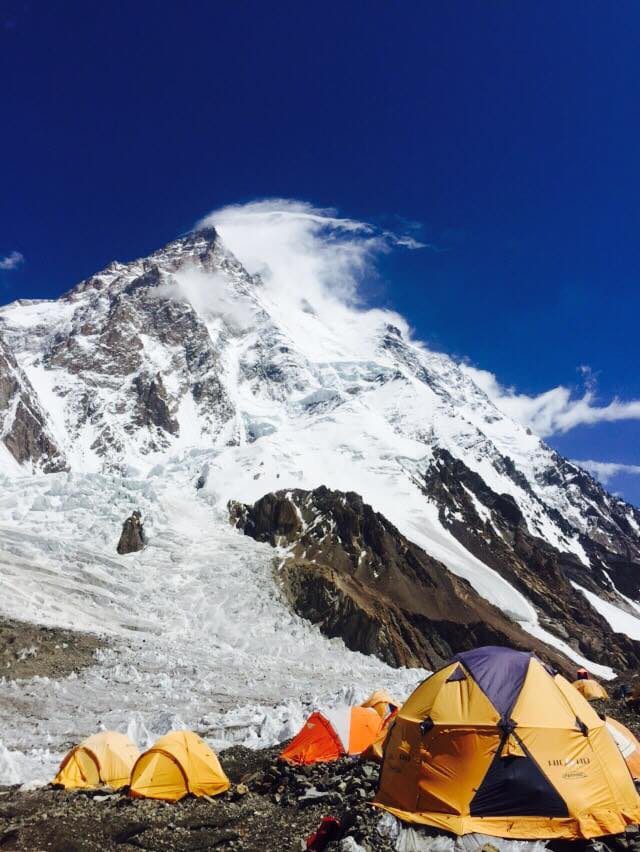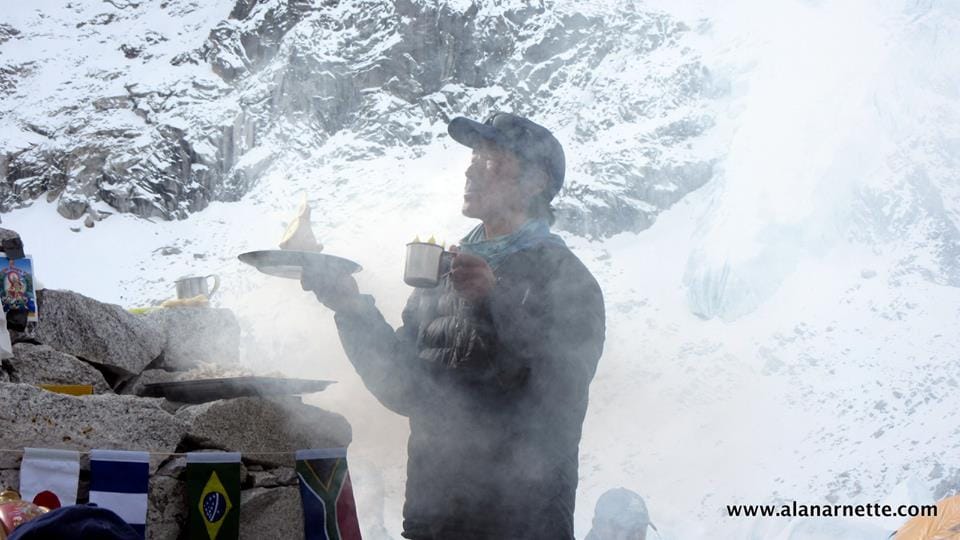It looks like most of the attempts on the major 8000 meter and surrounding peaks in Northern Pakistan have come to an end this summer season. A small Czech team continues to wait out weather on GI. You can follow them on their blog.
2016 will go down as another year with no summits of K2 and only a few for the other peaks. Similar to 2015, weather and snow conditions stopped many efforts. It appears that climbing the world’s 8000 meter mountains have become more unpredictable and difficult over the last few years.
As previously noted, it is a busy season on K2 but the other peaks seem to be about normal for permits. This is a list of the Karakorum 2016 Expeditions permits that were issued for all the Karakoram mountains this summer. The summary is:
| Peak | Permits | Summits |
| Gasherbrum I | 3 | 8 |
| Gasherbrum II | 6 | 8 |
| Gasherbrum I & II | 28 | |
| Gasherbrum IV | 2 | 2 |
| Total Gasherbrums | 39 | 18 |
| Nanga Parbat | 19 | 3 |
| Broad Peak | 19 | 2 |
| K2 & Broad Peak | 60 | |
| K2 | 62 | 0 |
| K2 Total | 112 | |
| other permits | 25 | ? |
Lets start with those peaks that saw teams summit:
Nanga Parbat: 3 Summits
At 26,660’/8126m Nanga is known to be one of the more technical 8000ers. There were several teams attempting by different routes but only the international team lead by Spaniard Ferran Latorre, with Frenchman Hélias Millerioux and Bulgarian Boyjan Petrov summited via the standard route aka Kinshofer route on the Diamir Face.
Latorre only has Everest to summit (hopefully in 2017) to complete all 14 of the 8000ers without supplemental Os. Petrov is also on track with eight of the 14 thus far.
They posted this nice video approaching the summit:
Gasherbrum II: 8 Summits
 At 26,362’/8035m. GII is often considered the most attainable of the Karakoram’s 8000ers. There have been about 334 summits of GI and 930 of GII.
At 26,362’/8035m. GII is often considered the most attainable of the Karakoram’s 8000ers. There have been about 334 summits of GI and 930 of GII.
My Colorado climbing buddy, Ryan Kushner and teammates Lee Jennings and Kelly Soohoo summited GII on 26 July 2016.
There were five other summiteers that same day including Dawa Gyalje Sherpa – Nepal, Ali Reza Sadpara – Pakistan, Liu Yongzhong – China, Armaan Haddad – Iran and Endong Cui – Canada.
They threaded yet another narrow weather window only to be caught at the last camp before BC to wait out heavy snow. Congratulations to all these climbers for a no Os summit.
Gasherbrum I: 8 Summits
Mingma Sherpa of Dreamers Destination based out of Nepal posted that a team of 8 summited GI on 4 August:
Now I am on the summit of Gasherbrun-I with my team. 1. Mingma Gyalje Sherpa 2. Dawa Gyalje Sherpa 3. Dakipa Sherpa 4. Ali Reza Sadpara 5. Zhang Liang 6. Liu Youngzhong 7. Dong Hongjuan +1 german Stefan
Three of this summit team, Dawa Gyalje Sherpa, Ali Reza Sadpara and Liu Yongzhong also reached the top of GII on 26 July.
Broad Peak: 2 Summits

Broad Peak continued to play hard for almost everyone. Last year only one climber snuck to the top in a narrow window and similarly this year on 29 June 2016 two Slovenians Luka Lindic and Ales Česen summited on a day when others turned back. They summited with no Os or fixed ropes.
There seems to be a trend in the Karakoram that if your hesitate you might miss an opportunity, however, this same practice of pushing it in narrow weather windows have resulted in many deaths over the years.
Of note was that 79 permits were issued this year for BP, 60 of those for the ambitious double that many people plan (and operators sell) but few ever accomplish. As we saw, K2 is hard enough, much less adding BP in the mix. Same goes for those wanting to double GI and GII. For those who pull it off, they deserve all the admiration they receive.
Gasherbrum IV: 2 Summits
Speaking of ambitious and deserving of rewards, the two Slovenians, Luka Lindic and Ales Česen, went on to reach the North Summit of G IV, only 20 meters shy of the true summit. They climbed via the Northwest ridge. They had planned on climbing the ‘Shining Wall’ on Gasherbrum IV, 7982 meters/26,197 feet, a feat on twice accomplished – 1985 and 1997. Similar to conditions across Northern Pakistan, deep snow thwarted their plans.
K2: No Summits
With 112 climbing permits issued, a record, K2 was expected to be crowded this year, and it was. There were several reports of waiting for up to two hours to climb Houses Chimney plus juggling the limited real estate for tents at Camps 1 and 2.
With one summit attempt stopped by bad weather, most of the teams targeted another somewhat narrow window around July 26 for a summit. But an expected, albeit stronger than forecasted, weather event dumped a lot of snow as climbers were at their Camps 1 and 2.

Then on July 23 a major avalanche that could have begun above Camp 4, swept away Camps 3 and 4 along with tents, oxygen bottles, food as well as burying the fixed ropes already in place.
The commercial teams of Madison Mountaineering and Kari Kobler made an almost immediate decision to abort their season with the Nepal outfitter for independent climbers, Seven Summits Treks with 44 members on their K2/Broad Peak permit quickly following suit. Given these three teams had the majority of Sherpa and Pakistani High Altitude Porters to fix the route, other teams were left to consider their options.
Adventure Peaks along with the Polish team met with the smaller teams including Vanessa O’brien and Nick Rice. They looked at the options of an alpine attempt, hiring the Sherpas and HAPS from other expeditions but in the end decided they could not make it without the support of the larger teams.
2016 saw an interesting twist in the commercialization of K2 with large commercial operators bringing a significant number of Sherpas from Nepal and individual climbers on their own permit also bringing an unusually large ratio of Nepal Sherpas to support them. Similar to what now occurs on Everest each year, the support staff outnumbers the aspiring climbers.
Mountaineering officials in Pakistan are starting to take a harder stand on ‘importing’ climbing support as it is seen as a threat to their own local support resources.
Thankfully, there were no injuries or deaths attributed to this year’s avalanche, but just like last year, there were no summits. It will be interesting to see who attempts K2 next summer and if the commercial operators can find enough members willing to pay $35,000 to $55,000 each while the no-frills expeditions run well under $20,000 and even half that if the individual assumes support from other teams.
Next up for K2 is perhaps another winter attempt lead by the world-class Polish climbers amongst others. K2 remains the only 8000 meter mountain without a winter summit. Nanga was the most recent peak to fall in the winter. K2 has been attempted several times including in 1987/88, 2002/3 and 2011/12. Visit this link for an excellent overview of the attempts.
Congratulations to all regardless of the result. It was a tough summer in the big mountains, lets hope autumn is a bit kinder.
Climb On!
Alan
Memories are Everything





3 thoughts on “K2 and Karakorum 2016 Wrap-Up”
I me think K2 overrated many smallest hard to climb
K2 is generally considered the hardest 8000 meter climb. The distinction include the absolute altitude, weather, objective dangers, etc. Obviously there are more technically difficult climbs of lower mountains.
> Next up for K2 is perhaps another winter attempt
Oh boy! It’s hard enough in the Summer, a Winter ascents seems more like fantasy at this point.
It’s good to see there’s at least one Pakistani that managed to summit an 8000er.
> Mountaineering officials in Pakistan are starting to take a harder stand on ‘importing’ climbing support as it is seen as a threat to their own local support resources.
As a Pakistani, I do agree with this in principle, but the fact of the matter is that we just do not have many (if any) people that have the required level of climbing experience that the sherpas in Nepal do.
In any case, the Pakistani government is much like Nepali government in the sense that there’s a lot of big talk, and never enough (if any) follow through.
Comments are closed.